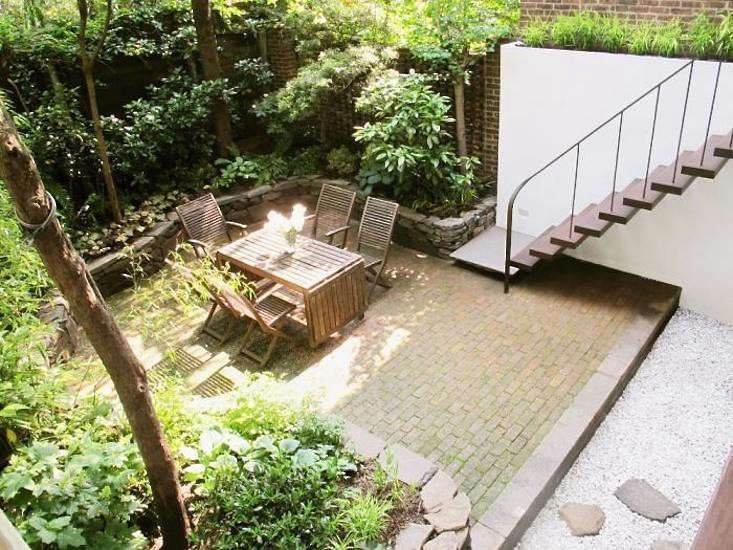Are you agonizing over which patio pavers to pick? Good. You should. The hardscape material you put underfoot will set the tone for your garden design. It’s a big decision. Let us help make it easier.
Patio pavers fall into two general categories: natural (stone or, in the case of brick, clay) and composite (such as concrete). Within those two broad groups are a zillion choices. Our editors have investigated the pros and cons (and prices) of materials such as bluestone, limestone, bricks, concrete pavers, and porous pavement surfaces such as concrete grid blocks.
And if you’re not sure you want pavers at all–maybe you’re considering a permeable surface such as pea gravel or decomposed granite?–we’ve got that covered too. Read on to find the right paving material for your patio.
Bluestone
Above: In a San Francisco city garden, landscape architect Scott Lewis created a spacious feeling with a wedge-shaped patio laid with bluestone in a running bond pattern. For more of this 25-by-40-foot garden, see Scott Lewis Turns a Small SF Backyard into an Urban Oasis.
Above: Photograph by Ellen Jenkins for Gardenista.
Bluestone comes in a variety of colors and textures. Shown above is a herringbone pattern laid with pavers in a full color range with a natural cleft. For more about choosing colors and textures, see Hardscaping 101: Bluestone Pavers.
Above: Photograph by Liesa Johannssen for Gardenista.
SF-based architect Barbara Chambers paved a small patio in her Mill Valley garden with the same color and texture of bluestone as the pavers she used on an adjacent path to increase the visual impact of the hardscape. For more of her garden, see Architect Visit: Barbara Chambers at Home in Mill Valley.
Above: Photograph by Ellen Jenkins for Gardenista.
Is bluestone the right material for your patio? We’ve look at all the pros and cons (and compared prices to other materials) in Hardscaping 101: Bluestone Pavers.
Limestone
Above: Photograph by Jim Powell for Gardenista.
Above: Limestone is a universal and timeless material. And accordingly expensive. To decide if the dense sedimentary rock is the right hardscaping material for your patio, see Hardscaping 101: Limestone Pavers.
Bricks
Above: Photographs courtesy of Julian King Architect.
For a remodel of a 19th century townhouse garden in Manhattan’s Chelsea neighborhood, architect Julian King used recycled bricks and stones found on site to pave the patio and edge garden beds. For more of this garden, see Before & After: A Garden Duplex in a Historic Chelsea Townhouse.
Above: Common brick patterns, courtesy of Rubio’s Masonry and Construction. For more information or an estimate, see Rubio’s.
Most bricks are composed of clay soil combined with lime and sand. Although red bricks are the most common, bricks come in many colors, including cream, grey, tan, buff, pink, brown, and black. For more options, see Hardscaping 101: Brick Patios.
When choosing a brick pattern, consider such factors as whether you want a space to look larger (or to minimize its bulk); how much money you have to invest (complex patterns are more labor intensive), and whether a pattern will look too busy against other hardscape elements in your garden. For more guidelines for choosing a brick pattern, see Hardscaping 101: Brick Patios.
Concrete Pavers
Above: In Big Sur, Marin-based landscape architect Eric Blasen softened the hard edges of a concrete patio with native plantings and evergreen trees. For more of this garden, see Architect Visit: The Medieval Mist and Mystery of Big Sur.
Above: Photograph by Marla Aufmuth for Gardenista.
Concrete pavers offer instant gratification, whether they’re the standard-issue variety from the home improvement store or an architect’s custom design, says Janet. They’re inexpensive, sturdy, and easy to lay. To find out if concrete pavers are the right material for your patio, explore the pros and cons in Hardscaping 101: Concrete Pavers.
Open Grids and Porous Pavement
Above: Photograph by Matthew Williams for Gardenista. When Steven Harris and Lucien Rees Roberts built their precisely detailed weekend retreat on a 50-acre swath of land in upstate New York, they laid a porous terrace and planted it with perennial thyme. For more of the project, see our book, Gardenista: The Definitive Guide to Stylish Outdoor Spaces.
Above: Asking for holes in pavement may sound as logical as wishing for holes in your head. But, using pervious surfaces is the smart and environmentally friendly thing to do,” says Janet. See her top choices for open grid concrete and porous pavements at Hardscaping 101: Eco-Friendly Paving Solutions.
Decomposed Granite
Above: Photograph by Ellen Jenkins. Decomposed granite is like gravel, but finer and more stable. For colors, sizes, and prices, see Hardscaping 101: Decomposed Granite.
Pea Gravel
Above: Photograph courtesy of Mosaic Gardens.
A circular pea gravel patio invites contemplation in Eugene, Oregon. For more of this garden, see Before & After: A Garden Makeover for a Ranch-Style House.
As gravel goes, it doesn’t get any better, says Ellen in Hardscaping 101: Pea Gravel. Rounded fragments of pea-size stone crunch underfoot as satisfyingly as crispy cereal.
Looking for inspiration? Comb through our Hardscaping 101 files for design ideas for Pergolas, Gate Latches, and Retaining Walls.
Finally, are you planning a Decks & Patios project? Learn everything you need to know on to get started with our Hardscaping 101: Decks & Patios 101 guide.
Also learn how to successfully use pavers in a landscape or garden project with our Hardscaping 101: Pavers guide.

























Have a Question or Comment About This Post?
Join the conversation (1)